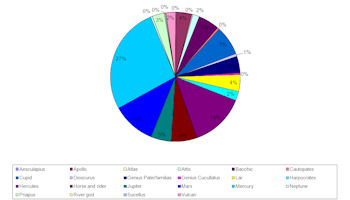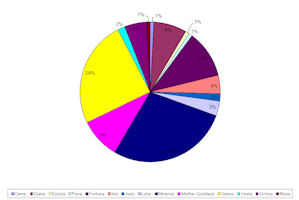

Figure 5: Proportions of male and female deities
The list below details the figurine types found in Britain, with short descriptions of the more common or interesting pieces. They are presented in groups that are ordered alphabetically beginning with the male, then female deities, humans, animals and birds. For the purposes of this study, only those figurines with a certain, or almost certain, identification have been counted with their type. Those with only suggested identifications were placed in the unassigned category, and the various possibilities listed in the database.
| Type | Number | Percentage of total number |
|---|---|---|
| Aesculapius | 1 | 0.1 |
| Apollo | 17 | 2.4 |
| Atlas | 1 | 0.1 |
| Attis | 7 | 1.0 |
| Bacchus and satyrs | 24 | 3.4 |
| Cautopates | 2 | 0.3 |
| Cupid | 32 | 4.5 |
| Dioscurus | 3 | 0.4 |
| Genius paterfamilias | 18 | 2.6 |
| Genius cucullatus | 2 | 0.3 |
| Lar | 18 | 2.6 |
| Harpocrates | 10 | 1.4 |
| Hercules | 59 | 8.4 |
| Horse and rider | 28 | 4.0 |
| Jupiter | 22 | 3.1 |
| Mars | 47 | 6.7 |
| Mercury | 116 | 16.5 |
| Neptune | 2 | 0.3 |
| Priapus | 13 | 1.8 |
| River God | 1 | 0.1 |
| Sucellus | 1 | 0.1 |
| Vulcan | 10 | 1.4 |
| Ceres | 1 | 0.1 |
| Diana | 9 | 1.3 |
| Epona | 1 | 0.1 |
| Flora | 1 | 0.1 |
| Fortuna | 13 | 1.8 |
| Isis | 5 | 0.7 |
| Juno | 2 | 0.3 |
| Luna | 4 | 0.6 |
| Minerva | 33 | 4.7 |
| Mother Goddess | 11 | 1.6 |
| Venus | 29 | 4.1 |
| Vesta | 2 | 0.3 |
| Victory | 6 | 0.8 |
| Muse | 1 | 0.1 |
| Uncertain male or female deities | 52 | 7.3 |
| Humans | 42 | 6.0 |
| Fragments | 58 | 8.2 |
| Total | 704 |
The types of male and female deities that have been identified are listed in Table 3 (of the 1000 figurines under consideration in this article, 704 are deities or human figures). It can be seen from Table 3 that the male deities comprise 61.5% of the total number of deities and human figurines, while female deities comprise only 16.6% and humans a mere 6%. The popularity of Mercury is emphasised by the fact that the number of Mercury figurines alone almost equals the total number of figurines of female deities.
Table 3 also shows that the variety of male deities (22 types) is greater than that of female deities (14 types). However, study of the proportions of the types in each group demonstrates that there are certain similarities (Figure 5). Both the male and female groups are dominated by one particular deity with almost the same proportion — Mercury comprises 27% of the male deities and Minerva 27% of the female deities. Among the female deities, however, Venus comprises only a slightly smaller proportion of the group (25%), meaning that Minerva and Venus make up half of the entire group. Other female deities that occur in smaller numbers are Fortuna, Diana and Mother Goddesses. Among the male deities the second most popular type, Hercules (14%), is only half as common as Mercury, and other popular deities such as Mars, Horse and riders and Cupid again form much smaller groups. Thus it appears that while the male deities form a much larger and more varied group, among both the male and female deities there were one or two particularly popular figurine types, with three or four other slightly less popular types, and a scattering of other forms.
© Internet Archaeology/Author(s)
University of York legal statements | Terms and Conditions
| File last updated: Tue Mar 20 2012